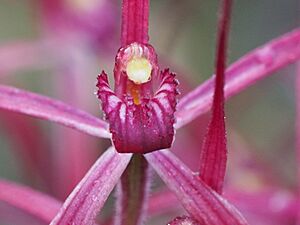Patricia's spider orchid facts for kids
The Patricia's spider orchid, also known as the Dundas spider orchid, is a special type of orchid. It grows only in a small area in the south-west of Western Australia. This rare flower has a single hairy leaf. It usually has one or two red flowers. These flowers have thin, stiff parts called sepals and petals.
Quick facts for kids Patricia's spider orchid |
|
|---|---|
 |
|
| Conservation status | |
| Scientific classification | |
| Genus: |
Caladenia
|
| Species: |
dundasiae
|
| Synonyms | |
|
|
Contents
What Patricia's Spider Orchid Looks Like
The Patricia's spider orchid has one upright, hairy leaf. This leaf is about 4.5 to 15 centimeters (1.8–5.9 inches) long. It is also about 2 to 4 millimeters (0.08–0.16 inches) wide. One or two flowers grow on a stalk. This stalk can be 15 to 35 centimeters (5.9–13.8 inches) tall.
The flowers are usually red. Sometimes they can be pink or cream-colored. The top sepal stands straight up. It is about 5.5 to 6.5 centimeters (2.2–2.6 inches) long. The side sepals are similar in size. But they spread out wide and point downwards. The petals are a bit shorter and narrower than the side sepals.
The labellum (the orchid's special lip petal) is 7 to 10 millimeters (0.28–0.39 inches) long. It is 4 to 6 millimeters (0.16–0.24 inches) wide. It is red with a white or cream-colored base. It has short teeth on its sides that point forward. There are two rows of red and white bumps, called calli, along the center of the labellum. These orchids bloom from July to August.
This orchid looks a bit like another species called C. erythrochila. However, the Patricia's spider orchid has shorter sepals and petals. They are also held more stiffly.
How it Got its Name
The Patricia's spider orchid was first officially described in 2001. This was done by two botanists, Stephen Hopper and Andrew Phillip Brown. They found a specimen (a sample) near a place called Watheroo. Their description was published in a science journal called Nuytsia.
The scientific name dundasiae was chosen to honor a botanical artist. Her name was Patricia Dundas.
Where it Lives and Grows
Patricia's spider orchid is only found in a small area. This area is near Watheroo in Western Australia. It grows in woodlands where trees like York gum and Wandoo grow. These areas are part of the Avon Wheatbelt and Geraldton Sandplains regions.
Protecting the Orchid
The Western Australian Government's Department of Parks and Wildlife has classified Caladenia dundasiae as "Priority One". This means it is a very rare plant. It is known from only a few places. These places might be at risk, so it is very important to protect this special orchid.



